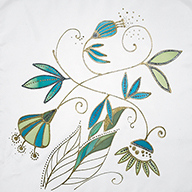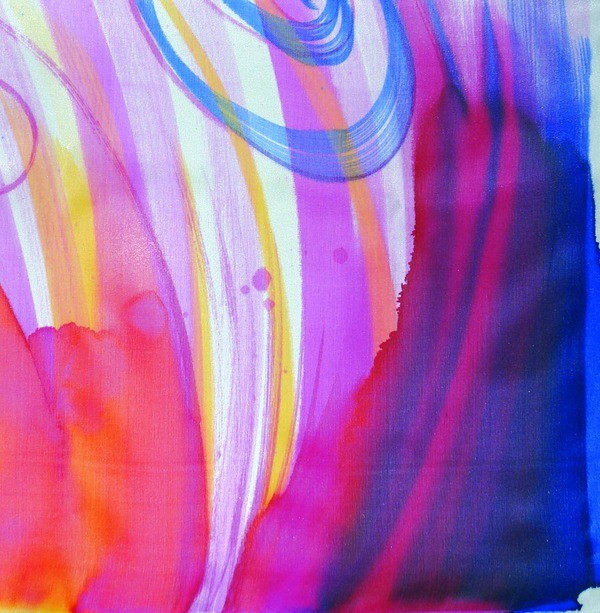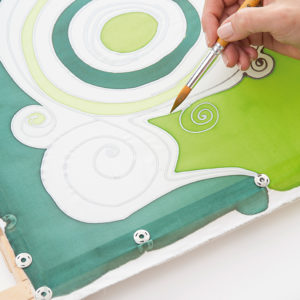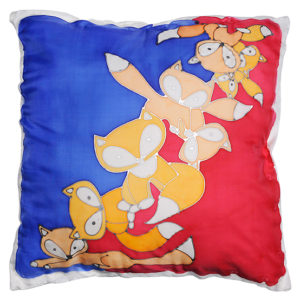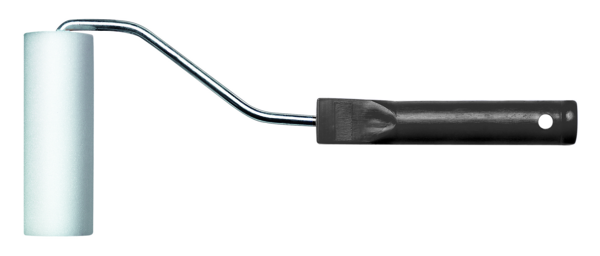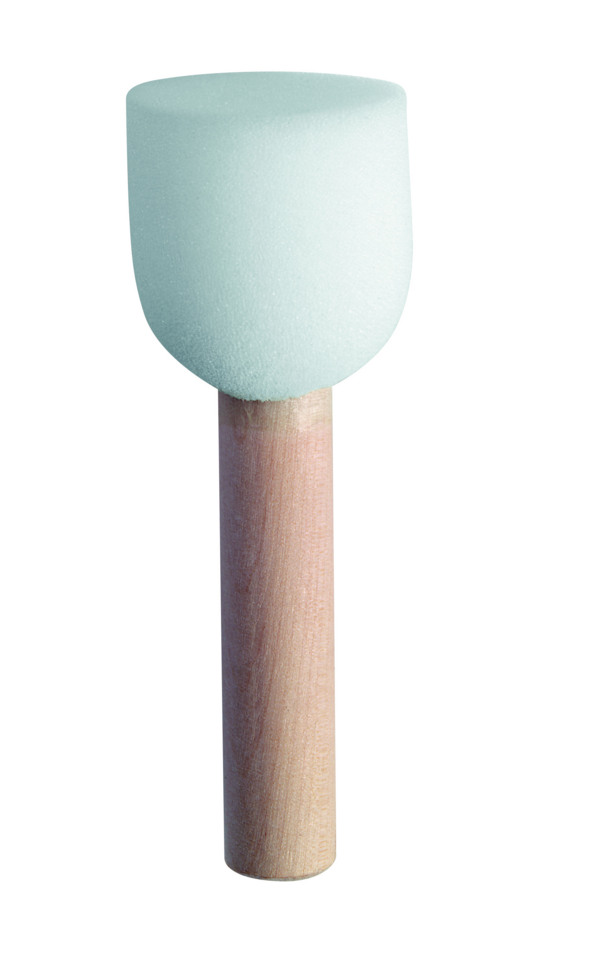Airbrushing with Marabu Silk
Using Marabu colours the airbrush technique offers a variety of great design possibilities on various substrates: from paper, wood & craft materials to glass & porcelain to textiles & silk.
Beautiful patterns or sharp outlines can be realised using this technique; photographically accurate pictures can be enhanced with special effects such as metallic gloss or mirror reflexes. The colour is mixed with the airflow in the spray pistol and is applied in extremely thin layers by constantly moving your hand. By varying the aperture of the nozzle, the distance to the painting substrate or by the use of stencils, there is no limit to your artistic scope.
General Advice:
Please follow the instructions for airbrush technique depending on paint type.
Further advice:
- Stir well before use or, if necessary, strain the colours.
- Choose the appropriate thinner for colour and substrate.
- The colour should be sufficiently liquid that it can pass through a teastrainer.
- The substrate should be dust and grease-free.
- Use self-adhesive templates.
- Ensure that the workplace is well ventilated and that spray mist is avoided.
- When changing colours, use the appropriate cleaning agent for the spray pistol - in the case of water-based Marabu-colours the appropriate cleaning agent is simply water.
- After use carefully clean all equipment with the appropriate cleaning materials.
- Always carry out pre-trials.
Separate instructions for airbrush technique depending on paint type:
Airbrushing with Marabu Silk
Nozzle size: from 0.2 mm
Pressure: from 2 bar
Thinning: not necessary
Cleaning: with water
The specifications shown for nozzle sizes, dilution and pressures are guidelines only and should be adjusted accordingly.Sun Technique
The 'sun technique' using Marabu Textil or Marabu Silk is an excellent new way of decorating fabrics!
Firstly dilute Marabu Textil using water and apply it in large areas onto a thin fabric; use Marabu Silk undiluted. Put an opaque motif onto the paint when it is still wet (you could use motifs such as hearts, triangles, stars etc cut out from cardboard, rubber sponge or natural materials like leaves) and weigh down. Now expose the covered fabric to sunlight or to a powerful lamp (the quickest way to dry the fabric is using a powerful hairdryer). Depending on the intensity of the light, the covered areas will dry a lighter colour than the rest - your masterpiece is finished! When the fabric is totally dry, as well as below the motifs, it can be fixed according to instructions.
Please note that the wash-quality of the colours can be affected when you use extreme levels of dilution.Stamping technique on silk
Modern silk painting on a firm support makes it possible to use stamps on silk.
Here`s how it`s done:
1. Stretch the silk onto a firm support as described.
2. Apply some paint - Marabu Velvet Touch, Marabu Contours & Effects or Marabu Silk in combination with Marabu Silk Thickener - onto an even surface (e.g. paper plate) and roll it out smoothly using a paint roller. Do not use too much paint otherwise the fine spaces in the stamp will get blocked up with paint.
3. Then press the Marabu Design Stamp into the paint, motif side down. Check that the motif is completely covered with paint. Carefully add more using the paint roller, if necessary.
4. You can now stamp on silk painted with Marabu Silk, silk dyed with Marabu Silk Color or on untreated silk fabrics. Press the stamp lightly and evenly onto the silk (approx. 10-15 sec.) so that the paint really seeps into the silk. If necessary, try the first stamp print on a test surface and press into the paint again.Silk painting on a stretching frame
Stretching the silk onto a wooden frame is the most popular stretching technique for silk painting.
Here`s how it`s done:
1. Stretch the silk onto a frame which is big enough using stretching fasteners or pins. Press the fasteners or pins into the frame, alternating right and left for the best results.
2. Now the silk can be painted - just as you like. First paint the outlines and allow them to dry well. Then paint in the motif with Marabu Silk.
3. As soon as the paint is dry, remove the silk and fix according to the instructions.Painting on a firm support
Stretching technique for untreated silk or silk painted with Marabu Silk
Here`s how it`s done:
1. You need a firm support (table, acrylic or glass plate etc.); if this is not washable, you will also need a washable film to cover the support first. Smooth the film over the support very evenly and stick with adhesive tape at one end. Then stretch the opposite side of the film tightly and stick. Use the same procedure for the sides until the film is smooth.
2. Spray Marabu Silk Easy Fix on the support or on the film and allow to dry for approx. 5-10 min. Ensure the area is completely sprayed.
3. Roll the silk fabric onto a cardboard tube or similar to control stretching better.
4. Lay the rolled out silk onto the area sprayed with Marabu Silk Easy Fix. Then gradually press the silk onto the painting support, brushing any small air bubbles away to the edges. Very small creases or air bubbles will not affect painting.
Further tips for stretching technique with Marabu Silk Easy Fix:
- The film can also be sprayed outside and stretched onto the painting support after drying.
- Particularly large silk fabrics can be painted on the floor. Glue the film on, spray, draw on the silk and start.
- Iron the silk before stretching.
- A sticky film can develop on the reverse side of the silk, which will disappear after fixing and washing.
- Using this new technique working on a firm support, silk painting is much easier for children.Colour flows on silk
Great blends of colour in Marabu Silk are produced with the help of paint rollers and kitchen roll.
Here`s how it`s done:
1. Stretch the silk onto a firm support with the help of Marabu Silk Easy Fix as described.
2. Dispense the chosen Marabu Silk shades into containers which are big enough to soak the paint rollers well. Using the rollers apply the shades in broad stripes next to each other. Work very quickly to avoid hard colour edges.
3. Now blend the shades into each other using the soft end of the paint roller.
4. Then roll the shades into each other by pressing firmly. A hard rubber roller can also be used instead of a paint roller. Remove surplus paint from the paint roller in between applications with kitchen paper.
5. When the desired result is achieved, allow Marabu Silk to dry and then remove it from the base.
6. Finally add accents with the desired paint and technique and fix all together after drying following the instructions.Outline technique on silk
Painting outlines on silk is really easy with Marabu Contours & Effects. The outlines are painted straight from the liner. Then the outlines are painted in with Marabu Silk.
Here`s how it`s done:
1. Simply put a pattern under the transparent film painting support or under the silk stretched onto a frame, then even difficult patterns can be easily copied.
2. Shake Marabu Contours & Effects in the direction of the liner tip to avoid drops of paint through air bubbles.
Important: The outlines must be solid otherwise the silk paint will bleed through.
3. Allow the outlines to dry very well before painting in with Marabu Silk to prevent the silk paint from bleeding through. Do not to apply too much paint to the silk with the brush when filling in the outlines, as otherwise the shapes will be flooded.
4. Then fix all together following the instructions.Stencilling technique on silk
Add new highlights with versatile stencils from Marabu. There is nothing in the way of stencilling on silk on a firm support!
Here`s how it`s done:
1. Stretch the silk onto a firm support as described.
2. Spray stencil with Marabu Silk Easy Fix, Marabu Adhesive Spray or Marabu Fix-it and allow to dry briefly. Place it in the chosen position and firmly press onto the silk painted with Marabu Silk, dyed with Marabu Silk Color or onto the white silk fabric. Cover the stencils with kitchen paper to make it easy to smooth out the paint.
3. Do not use too much paint: When painting with Marabu Velvet Touch, Marabu Contours & Effects and thickened Marabu Silk using a stencilling brush, dab off surplus paint onto scrap paper first. When you work with a paint roller, roll the paint out smoothly onto a paper plate, for example, before stencilling. This prevents excess paint from getting under the stencil.
4. Remove the stencil when still wet.
5. The stencil can be re-used several times when sprayed just once with Marabu Silk Easy Fix, Marabu Adhesive Spray or Marabu Fix-it. After completion, rinse stencil under cold water.Monotype technique on silk
This printing technique produces unintentional and sophisticated results: unique and changing pictures and effects are achieved with each print - whether freehand or with the help of a pattern.
Here`s how it`s done:
1. Paint the motif with Marabu Velvet Touch, Marabu Contours & Effects or thickened Marabu Silk on a painting base. While doing so a pattern can be put under the transparent base. For monotype technique, it doesn't matter whether you paint precisely. Particularly beautiful effects can be obtained with Marabu Velvet Touch.
2. Draw the desired pattern into the paint using a rubber brush or similar.
3. Place the painted side of the base onto the silk fabric painted with Marabu Silk, dyed with Marabu Silk Color or onto the white silk fabric.
4. Carefully lift the base off, and it's finished!
5. If desired, fine details can be directly added with the liner or with a brush.Masking technique on silk
Striped patterns on silk can be achieved without outlines: mask all areas not to be painted with adhesive tape. To obtain exact stripes even for large pieces, measure and mark the desired width at each side first. Then paint in with thickened Marabu Silk, Marabu Contours & Effects or Velvet Touch using a paint roller or stencilling brush. Do not use too much paint.
Then allow to dry and mask stripes again or continue working with stencils and stamps. Remove the adhesive tape when still wet, then allow to dry.
TIP: Start from the middle when removing the adhesive tape. Carefully lift the tape and tear it sideways. This prevents the area of painted silk from lifting up.Free painting on silk
Design your motifs "freehand".
First of all choose a brush for your design. The stronger the brush hairs the more visible the brush strokes will remain after fixing. When you paint with Marabu Velvet Touch, we recommend a very soft brush so that the velvety effect is particularly successful. Thickened Marabu Silk can also be used.Watercolour technique on silk
The watercolour technique with Marabu Silk is one of the original painting techniques - with superb effects. Let the colours flow!
Here`s how it`s done:
Apply your favourite combination of colours one after another to produce exciting blends.
When painting wet on wet, the colours flow softly into one another and produce gentle waves. For this purpose, damp the silk with water before painting.
Unusual lines develop when dry when painting wet on dry, either directly onto dry silk or onto dried paint.
Both techniques result in a wonderful range of colours as you paint.
Using Marabu colours the airbrush technique offers a variety of great design possibilities on various substrates: from paper, wood & craft materials to glass & porcelain to textiles & silk.
Beautiful patterns or sharp outlines can be realised using this technique; photographically accurate pictures can be enhanced with special effects such as metallic gloss or mirror reflexes. The colour is mixed with the airflow in the spray pistol and is applied in extremely thin layers by constantly moving your hand. By varying the aperture of the nozzle, the distance to the painting substrate or by the use of stencils, there is no limit to your artistic scope.
General Advice:
Please follow the instructions for airbrush technique depending on paint type.
Further advice:
- Stir well before use or, if necessary, strain the colours.
- Choose the appropriate thinner for colour and substrate.
- The colour should be sufficiently liquid that it can pass through a teastrainer.
- The substrate should be dust and grease-free.
- Use self-adhesive templates.
- Ensure that the workplace is well ventilated and that spray mist is avoided.
- When changing colours, use the appropriate cleaning agent for the spray pistol - in the case of water-based Marabu-colours the appropriate cleaning agent is simply water.
- After use carefully clean all equipment with the appropriate cleaning materials.
- Always carry out pre-trials.
Separate instructions for airbrush technique depending on paint type:
Airbrushing with Marabu Silk
Nozzle size: from 0.2 mm
Pressure: from 2 bar
Thinning: not necessary
Cleaning: with water
The specifications shown for nozzle sizes, dilution and pressures are guidelines only and should be adjusted accordingly.Sun Technique
The 'sun technique' using Marabu Textil or Marabu Silk is an excellent new way of decorating fabrics!
Firstly dilute Marabu Textil using water and apply it in large areas onto a thin fabric; use Marabu Silk undiluted. Put an opaque motif onto the paint when it is still wet (you could use motifs such as hearts, triangles, stars etc cut out from cardboard, rubber sponge or natural materials like leaves) and weigh down. Now expose the covered fabric to sunlight or to a powerful lamp (the quickest way to dry the fabric is using a powerful hairdryer). Depending on the intensity of the light, the covered areas will dry a lighter colour than the rest - your masterpiece is finished! When the fabric is totally dry, as well as below the motifs, it can be fixed according to instructions.
Please note that the wash-quality of the colours can be affected when you use extreme levels of dilution.Stamping technique on silk
Modern silk painting on a firm support makes it possible to use stamps on silk.
Here`s how it`s done:
1. Stretch the silk onto a firm support as described.
2. Apply some paint - Marabu Velvet Touch, Marabu Contours & Effects or Marabu Silk in combination with Marabu Silk Thickener - onto an even surface (e.g. paper plate) and roll it out smoothly using a paint roller. Do not use too much paint otherwise the fine spaces in the stamp will get blocked up with paint.
3. Then press the Marabu Design Stamp into the paint, motif side down. Check that the motif is completely covered with paint. Carefully add more using the paint roller, if necessary.
4. You can now stamp on silk painted with Marabu Silk, silk dyed with Marabu Silk Color or on untreated silk fabrics. Press the stamp lightly and evenly onto the silk (approx. 10-15 sec.) so that the paint really seeps into the silk. If necessary, try the first stamp print on a test surface and press into the paint again.Silk painting on a stretching frame
Stretching the silk onto a wooden frame is the most popular stretching technique for silk painting.
Here`s how it`s done:
1. Stretch the silk onto a frame which is big enough using stretching fasteners or pins. Press the fasteners or pins into the frame, alternating right and left for the best results.
2. Now the silk can be painted - just as you like. First paint the outlines and allow them to dry well. Then paint in the motif with Marabu Silk.
3. As soon as the paint is dry, remove the silk and fix according to the instructions.Painting on a firm support
Stretching technique for untreated silk or silk painted with Marabu Silk
Here`s how it`s done:
1. You need a firm support (table, acrylic or glass plate etc.); if this is not washable, you will also need a washable film to cover the support first. Smooth the film over the support very evenly and stick with adhesive tape at one end. Then stretch the opposite side of the film tightly and stick. Use the same procedure for the sides until the film is smooth.
2. Spray Marabu Silk Easy Fix on the support or on the film and allow to dry for approx. 5-10 min. Ensure the area is completely sprayed.
3. Roll the silk fabric onto a cardboard tube or similar to control stretching better.
4. Lay the rolled out silk onto the area sprayed with Marabu Silk Easy Fix. Then gradually press the silk onto the painting support, brushing any small air bubbles away to the edges. Very small creases or air bubbles will not affect painting.
Further tips for stretching technique with Marabu Silk Easy Fix:
- The film can also be sprayed outside and stretched onto the painting support after drying.
- Particularly large silk fabrics can be painted on the floor. Glue the film on, spray, draw on the silk and start.
- Iron the silk before stretching.
- A sticky film can develop on the reverse side of the silk, which will disappear after fixing and washing.
- Using this new technique working on a firm support, silk painting is much easier for children.Colour flows on silk
Great blends of colour in Marabu Silk are produced with the help of paint rollers and kitchen roll.
Here`s how it`s done:
1. Stretch the silk onto a firm support with the help of Marabu Silk Easy Fix as described.
2. Dispense the chosen Marabu Silk shades into containers which are big enough to soak the paint rollers well. Using the rollers apply the shades in broad stripes next to each other. Work very quickly to avoid hard colour edges.
3. Now blend the shades into each other using the soft end of the paint roller.
4. Then roll the shades into each other by pressing firmly. A hard rubber roller can also be used instead of a paint roller. Remove surplus paint from the paint roller in between applications with kitchen paper.
5. When the desired result is achieved, allow Marabu Silk to dry and then remove it from the base.
6. Finally add accents with the desired paint and technique and fix all together after drying following the instructions.Outline technique on silk
Painting outlines on silk is really easy with Marabu Contours & Effects. The outlines are painted straight from the liner. Then the outlines are painted in with Marabu Silk.
Here`s how it`s done:
1. Simply put a pattern under the transparent film painting support or under the silk stretched onto a frame, then even difficult patterns can be easily copied.
2. Shake Marabu Contours & Effects in the direction of the liner tip to avoid drops of paint through air bubbles.
Important: The outlines must be solid otherwise the silk paint will bleed through.
3. Allow the outlines to dry very well before painting in with Marabu Silk to prevent the silk paint from bleeding through. Do not to apply too much paint to the silk with the brush when filling in the outlines, as otherwise the shapes will be flooded.
4. Then fix all together following the instructions.Stencilling technique on silk
Add new highlights with versatile stencils from Marabu. There is nothing in the way of stencilling on silk on a firm support!
Here`s how it`s done:
1. Stretch the silk onto a firm support as described.
2. Spray stencil with Marabu Silk Easy Fix, Marabu Adhesive Spray or Marabu Fix-it and allow to dry briefly. Place it in the chosen position and firmly press onto the silk painted with Marabu Silk, dyed with Marabu Silk Color or onto the white silk fabric. Cover the stencils with kitchen paper to make it easy to smooth out the paint.
3. Do not use too much paint: When painting with Marabu Velvet Touch, Marabu Contours & Effects and thickened Marabu Silk using a stencilling brush, dab off surplus paint onto scrap paper first. When you work with a paint roller, roll the paint out smoothly onto a paper plate, for example, before stencilling. This prevents excess paint from getting under the stencil.
4. Remove the stencil when still wet.
5. The stencil can be re-used several times when sprayed just once with Marabu Silk Easy Fix, Marabu Adhesive Spray or Marabu Fix-it. After completion, rinse stencil under cold water.Monotype technique on silk
This printing technique produces unintentional and sophisticated results: unique and changing pictures and effects are achieved with each print - whether freehand or with the help of a pattern.
Here`s how it`s done:
1. Paint the motif with Marabu Velvet Touch, Marabu Contours & Effects or thickened Marabu Silk on a painting base. While doing so a pattern can be put under the transparent base. For monotype technique, it doesn't matter whether you paint precisely. Particularly beautiful effects can be obtained with Marabu Velvet Touch.
2. Draw the desired pattern into the paint using a rubber brush or similar.
3. Place the painted side of the base onto the silk fabric painted with Marabu Silk, dyed with Marabu Silk Color or onto the white silk fabric.
4. Carefully lift the base off, and it's finished!
5. If desired, fine details can be directly added with the liner or with a brush.Masking technique on silk
Striped patterns on silk can be achieved without outlines: mask all areas not to be painted with adhesive tape. To obtain exact stripes even for large pieces, measure and mark the desired width at each side first. Then paint in with thickened Marabu Silk, Marabu Contours & Effects or Velvet Touch using a paint roller or stencilling brush. Do not use too much paint.
Then allow to dry and mask stripes again or continue working with stencils and stamps. Remove the adhesive tape when still wet, then allow to dry.
TIP: Start from the middle when removing the adhesive tape. Carefully lift the tape and tear it sideways. This prevents the area of painted silk from lifting up.Free painting on silk
Design your motifs "freehand".
First of all choose a brush for your design. The stronger the brush hairs the more visible the brush strokes will remain after fixing. When you paint with Marabu Velvet Touch, we recommend a very soft brush so that the velvety effect is particularly successful. Thickened Marabu Silk can also be used.Watercolour technique on silk
The watercolour technique with Marabu Silk is one of the original painting techniques - with superb effects. Let the colours flow!
Here`s how it`s done:
Apply your favourite combination of colours one after another to produce exciting blends.
When painting wet on wet, the colours flow softly into one another and produce gentle waves. For this purpose, damp the silk with water before painting.
Unusual lines develop when dry when painting wet on dry, either directly onto dry silk or onto dried paint.
Both techniques result in a wonderful range of colours as you paint.
Dispensing the paint
The special top of the 250 ml Silk bottle allows clean drop by drop dispensing of the paint. Outlines and embellishments on silk
Particularly delicate outlines and embellishments with Marabu Contours & Effects can be achieved with the Marabu metal paint tips which can simply be placed on the plastic tip of the liner tube. Do not use the 0.3 mm tip for Glitter paints as the glitter particles are too large and could clog the tip.Painting on cotton
Silk can be used for painting on thin cotton, but Marabu Textil is more suitable for this.Blocking with thickened Marabu Silk
Once dry, thickened Marabu Silk will block the (not thickened) Marabu Silk paints like an outline. Mix Marabu Silk with Marabu Thickener as usual (ratio 1:1). Stretch the silk across a hard surface and use the thickened paint to draw lines or for stencilling (see masking technique on silk). Allow everything to dry thoroughly. Use a synthetic brush to let the non-thickened Marabu Silk glide towards the patterns and embellishments, taking care not to use too much paint. Work rapidly to prevent dried edges.Fine and large-area painting
If you quickly need a thin outline, e.g. for a monogram, simply place a Marabu paint tip on the Contours & Effects Liner. Large silk areas can be painted with a wide brush, a sponge or cotton wool.Tips for Silk beginners
Stretch the silk tightly over the frame or a hard surface. Coloured outlines or effects are fixed together with the silk paint; clear outlines, thickener or salt residue can be washed out in lukewarm water after fixing.Tone-on-tone creations
Apply Marabu Silk as a base coat and after drying stamp or stencil with thickened Marabu Silk paint in the same colour. The design will appear one shade darker and creates a great tone-on-tone effect.Diluting
Marabu Silk can be diluted with water. When a colour is diluted extremely (more than 20 parts water), 25% painting medium has to be added. This increases washability and brilliance of the colour.
The special top of the 250 ml Silk bottle allows clean drop by drop dispensing of the paint. Outlines and embellishments on silk
Particularly delicate outlines and embellishments with Marabu Contours & Effects can be achieved with the Marabu metal paint tips which can simply be placed on the plastic tip of the liner tube. Do not use the 0.3 mm tip for Glitter paints as the glitter particles are too large and could clog the tip.Painting on cotton
Silk can be used for painting on thin cotton, but Marabu Textil is more suitable for this.Blocking with thickened Marabu Silk
Once dry, thickened Marabu Silk will block the (not thickened) Marabu Silk paints like an outline. Mix Marabu Silk with Marabu Thickener as usual (ratio 1:1). Stretch the silk across a hard surface and use the thickened paint to draw lines or for stencilling (see masking technique on silk). Allow everything to dry thoroughly. Use a synthetic brush to let the non-thickened Marabu Silk glide towards the patterns and embellishments, taking care not to use too much paint. Work rapidly to prevent dried edges.Fine and large-area painting
If you quickly need a thin outline, e.g. for a monogram, simply place a Marabu paint tip on the Contours & Effects Liner. Large silk areas can be painted with a wide brush, a sponge or cotton wool.Tips for Silk beginners
Stretch the silk tightly over the frame or a hard surface. Coloured outlines or effects are fixed together with the silk paint; clear outlines, thickener or salt residue can be washed out in lukewarm water after fixing.Tone-on-tone creations
Apply Marabu Silk as a base coat and after drying stamp or stencil with thickened Marabu Silk paint in the same colour. The design will appear one shade darker and creates a great tone-on-tone effect.Diluting
Marabu Silk can be diluted with water. When a colour is diluted extremely (more than 20 parts water), 25% painting medium has to be added. This increases washability and brilliance of the colour.
Oven fixing Silk, Contours & Effects
Can Marabu Silk, Contours & Effects also be fixed in the oven?
Yes. Place the silk loosely e.g. on aluminium foil or baking paper on a clean shelf and fix for 8 minutes at 150 °C in a pre-heated oven. Reposition large pieces of silk during the fixing time so all sections are heated evenly.Silk bleeding off after fixing with iron
Why does Marabu Silk bleed off so much after washing?
Verify the fixing process: Marabu Silk has to be fixed for 2-3 minutes on the back of each painted area (30 x 30 cm) using the cotton setting (150 °C) while constantly moving the iron. Fixing a textile of approx. 90 x 90 cm takes approx. 8 minutes. After a resting period of several hours, very carefully wash the textile by loosely floating it in a sink using delicate or liquid detergent - do not wring!Blocking the Silk paint when using Contours & Effects for contouring
Why does Marabu Contours & Effects not block the Silk paints effectively?
This can have various reasons, originating from how the outlines and the silk paint have been applied. It is important that the Marabu Contours & Effects penetrates the silk and that the outlines are completely continuous. Critical spots can be found by holding the fabric up to the light. Allow the outlines to dry thoroughly. Then apply the silk paint carefully and not too liberally to allow the paint to slowly approach the separating lines. Do not fill in any areas next to paint that is still wet.Dyeing silk scarves
What can I use to dye silk scarves?
Silk scarves can be dyed with Marabu Easy Color. The dyed silk can be washed by hand up to 40 °C.Fixing Silk
How do I fix Marabu Silk?
Marabu Silk has to be fixed with an iron or in the oven after drying. Set the iron to cotton temperature and iron from the reverse through a thin cotton cloth or a sheet of baking paper for 2-3 minutes (for each 30 x 30 cm section). Keep moving the iron throughout. The silk can alternatively be fixed in a pre-heated oven at 150 °C for approx. 8 minutes. We recommend placing the silk on a sheet of baking paper to avoid unwanted burnt patches. This type of fixing is not suitable for large silk fabrics.
Can Marabu Silk, Contours & Effects also be fixed in the oven?
Yes. Place the silk loosely e.g. on aluminium foil or baking paper on a clean shelf and fix for 8 minutes at 150 °C in a pre-heated oven. Reposition large pieces of silk during the fixing time so all sections are heated evenly.Silk bleeding off after fixing with iron
Why does Marabu Silk bleed off so much after washing?
Verify the fixing process: Marabu Silk has to be fixed for 2-3 minutes on the back of each painted area (30 x 30 cm) using the cotton setting (150 °C) while constantly moving the iron. Fixing a textile of approx. 90 x 90 cm takes approx. 8 minutes. After a resting period of several hours, very carefully wash the textile by loosely floating it in a sink using delicate or liquid detergent - do not wring!Blocking the Silk paint when using Contours & Effects for contouring
Why does Marabu Contours & Effects not block the Silk paints effectively?
This can have various reasons, originating from how the outlines and the silk paint have been applied. It is important that the Marabu Contours & Effects penetrates the silk and that the outlines are completely continuous. Critical spots can be found by holding the fabric up to the light. Allow the outlines to dry thoroughly. Then apply the silk paint carefully and not too liberally to allow the paint to slowly approach the separating lines. Do not fill in any areas next to paint that is still wet.Dyeing silk scarves
What can I use to dye silk scarves?
Silk scarves can be dyed with Marabu Easy Color. The dyed silk can be washed by hand up to 40 °C.Fixing Silk
How do I fix Marabu Silk?
Marabu Silk has to be fixed with an iron or in the oven after drying. Set the iron to cotton temperature and iron from the reverse through a thin cotton cloth or a sheet of baking paper for 2-3 minutes (for each 30 x 30 cm section). Keep moving the iron throughout. The silk can alternatively be fixed in a pre-heated oven at 150 °C for approx. 8 minutes. We recommend placing the silk on a sheet of baking paper to avoid unwanted burnt patches. This type of fixing is not suitable for large silk fabrics.
usage examples
